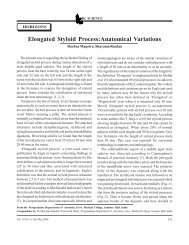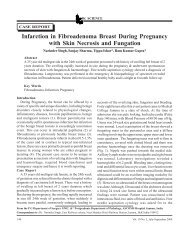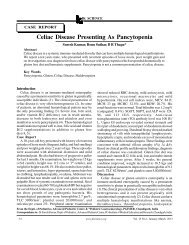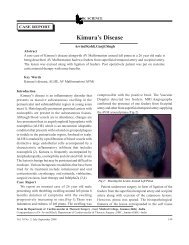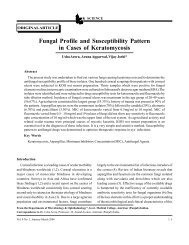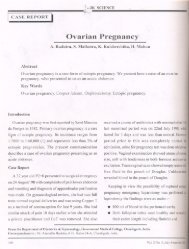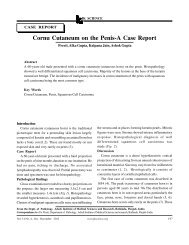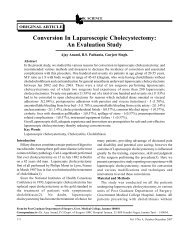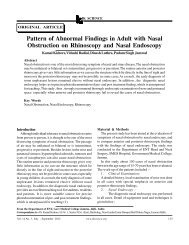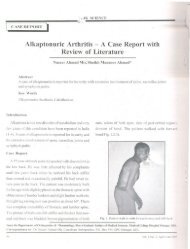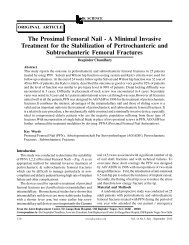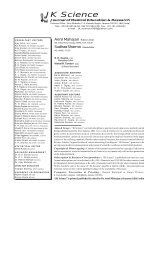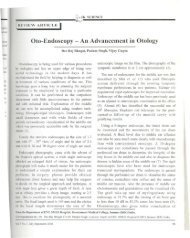6-Original Article - cell phones - JK Science
6-Original Article - cell phones - JK Science
6-Original Article - cell phones - JK Science
Create successful ePaper yourself
Turn your PDF publications into a flip-book with our unique Google optimized e-Paper software.
ORIGINAL ARTICLE<br />
<strong>JK</strong> SCIENCE<br />
Cell<strong>phones</strong> A Modern Stayhouse For Bacterial Pathogens<br />
Usha Arora, Pushpa Devi, Aarti Chadha, Sita Malhotra<br />
Abstract<br />
Cell<strong>phones</strong> are increasingly used by health care personnels for communication. These can harbour various<br />
potential pathogens and become an exogenous source of nosocomial infections. A total of 160 <strong>cell</strong><strong>phones</strong><br />
belonging to doctors and paramedical staff working in various departments at govt. medical college and<br />
hospital, Amritsar were screened for bacterial isolates. Sterile swabs moistened with nutrient broth were<br />
used to swab the front, back and the sides of the <strong>cell</strong><strong>phones</strong> and were subjected to culture and sensitivity.<br />
The same procedure was repeated after decontamination with 70% iso propyl alcohol.Out of total 160<br />
<strong>cell</strong><strong>phones</strong> growth was obtained in 65(40.62%) <strong>cell</strong><strong>phones</strong>. 31(19.37%) from clinical workers and<br />
34(21.25%) from non clinical workers. Coagulase negative staphylococcus was the most commonly isolated<br />
organism.The efficacy of decontamination with 70% isopropyl alcohol was found to be 98% as only 5<br />
<strong>cell</strong><strong>phones</strong> showed growth after decontamination.It was found that around 40% of the <strong>cell</strong><strong>phones</strong> of<br />
health care workers were contaminated and thus acted as a potential source of nosocomial infections.<br />
Simple measures like decontamination with 70% isopropyl alcohol was found to be 98% effective.<br />
Key Words<br />
Cell<strong>phones</strong>, Microorganism, Nosocomial Infections<br />
Introduction<br />
Today India has 287 million mobile phone users and<br />
these account for 85% of all the telecommunication users<br />
(1). With recent advances in the source of information,<br />
use of mobile <strong>phones</strong> has become indispensible in the<br />
hospitals (2). These can be put in vibratory mode in<br />
Intensive care units, Post operative wards and operation<br />
theatres etc (3). But however they are seldom cleaned<br />
and are often touched during or after examination of<br />
patients and handling of specimens without proper hand<br />
washing (3). These <strong>cell</strong>s <strong>phones</strong> can harbour various<br />
potential pathogens and become an exogenous source of<br />
nosocomial infection among hospitalised patients and also<br />
a potential health hazard for self and family members<br />
(2). In a study it was discovered the average <strong>cell</strong> phone<br />
is dirtier than either a toilet seat or the bottom of your<br />
shoe (4). However no study has been conducted out in<br />
this part of country. Our study was carried out to know<br />
the carriage rate of <strong>cell</strong> <strong>phones</strong> of health care persons<br />
working in various departments of our hospital.<br />
Material and Methods<br />
A total of 160 <strong>cell</strong> <strong>phones</strong> belonging to health care<br />
personnels from both clinical and non clinical departments<br />
of Govt. Medical College and Hospital, Amritsar were<br />
screened for bacterial isolates for a duration of 9 months<br />
from Jan 08 to Sept 08. Sterile swabs soaked in Nutrient<br />
broth were used for swabbing the front, the back and the<br />
sides of <strong>cell</strong><strong>phones</strong>. This was followed by decontamination<br />
of <strong>cell</strong> <strong>phones</strong> with 70% isopropyl alcohol. After allowing<br />
it to dry for 10 minutes, repeat swabs were taken from<br />
the <strong>cell</strong> <strong>phones</strong>. These swabs were brought to the<br />
department of Microbiology, where they were subjected<br />
to culture on blood agar and Mac Conkey agar. After<br />
incubation for 24 hours at 37 degree Celsius, the growth<br />
obtained was identified on the basis of colonial characters,<br />
From the PG Department of Microbiology, Government Medical College, Amritsar, Punjab-India.<br />
Correspondence to : Dr. Usha Arora, Prof & Head, PG Department of Microbiology, Govt.Medical College, Amritsar, Punjab-India<br />
Vol. 11 No. 3, July-September 2009 www.jkscience.org 127
<strong>JK</strong> SCIENCE<br />
morphology by gram staining and various bio chemical<br />
tests following standard procedures (5). The isolates were<br />
further subjected to antibiotic sensitivity testing by Kirby-<br />
Bauer method (6). The results were interpreted according<br />
to CLSI guidelines (7).<br />
Results<br />
Out of total 160 <strong>cell</strong> <strong>phones</strong> growth was obtained in<br />
65(40.62%) <strong>cell</strong> <strong>phones</strong> 31 (19.37%) from clinical<br />
departments and 34(21.25%) from non clinical<br />
departments as shown in table 1.Out of the total organism<br />
isolated coagulase negative staphylococcus was the most<br />
common followed by staphylococcus aureus and E.Coli<br />
both from clinical and non clinical departments. Various<br />
organisms isolated are shown in table 2. MRSA and<br />
E.Coli were mainly isolated from <strong>cell</strong> <strong>phones</strong> of health<br />
care personnels performing surgeries or handling acutely<br />
ill patients and could transfer this MRSA to the patients.<br />
Acenitobacter spp. was isolated from the <strong>cell</strong> <strong>phones</strong> of<br />
2 clinicians working in intensive care unit of the hospital.It<br />
was observed that <strong>cell</strong> <strong>phones</strong> from the health care<br />
personnels working in clinical departments showed higher<br />
carriage rate as compared to those from non clinical side<br />
as shown in table 3. After decontamination with 70%<br />
isopropyl alcohol only 5 <strong>cell</strong> <strong>phones</strong> showed growth again<br />
thus proving the efficacy of decontamination to be nearly<br />
98% shown in table 4. From the antibiotic sensitivity<br />
testing, it was observed that most of the isolates obtained<br />
from <strong>cell</strong> <strong>phones</strong> of clinical workers were showing growth<br />
of multi drug resistant organisms as compared to those<br />
isolated from non clinical sections.<br />
Table 1. Number of Cell<strong>phones</strong> Showing Growth<br />
Department Growth Obtained No growth Total<br />
Clinical 31 39 70<br />
Non- clinical 34 56 90<br />
Total 65 95 160<br />
Table 2 . Microorganism Isolated From Cell Phones of Clinical<br />
and Non Clinical Departments<br />
Isolates Clinical Non-Clinical<br />
1. Coagulase negative staphylococci 15 12<br />
2. staphylococcus aureus 10 12<br />
3. E. coli 10 5<br />
4 Klebseilla 5 2<br />
5. Micrococcus 4 3<br />
6. Bacillus spp. 3 2<br />
7. Acinetobacter spp. 2 1<br />
8. Citrobactor spp. 1 -<br />
9. Streptococcus viridans - 1<br />
Table 3. Showing Growth Pattern<br />
Department Total Samples Postive Growth % age<br />
Clinical 70 31 44.78<br />
Non Clinical 90 34 37.77<br />
Table 4. Showing Results After Decontamination of Cell Phones<br />
With 70 % Iso Proply Alcohol<br />
Cell Phones Growth Postive Growth Negative Total<br />
Before Decontamination 65 95 160<br />
After Decontamination 5 155 160<br />
Discussion<br />
In the world over, microbiological standards in hygiene<br />
are prerequisite for a healthy living. Out of total 160 <strong>cell</strong><br />
<strong>phones</strong> growth was obtained in 65(40.62%) <strong>cell</strong> <strong>phones</strong><br />
31 (19.37%) from clinical departments and 34 (21.25%)<br />
from non clinical departments (Table 1). This study is in<br />
contrast with the findings of another study, which showed<br />
positivity of 91.60% (3).This might be because of less<br />
frequent usage of these devices by health care workers<br />
in our institution. Out of the total organism isolated<br />
coagulase negative staphylococcus was the most common<br />
organism (Table 2). This goes well with the results of<br />
study at Coimbatore (3) showing isolation of coagulase<br />
negative staphylococcus in 108 out of 229 bacterial<br />
isolates obtained. This is a well known fact that organisms<br />
like staphylococcus aureus and coagulase negative<br />
staphylococcus resist drying and thus can survive and<br />
multiply rapidly in the warm environments like <strong>cell</strong> <strong>phones</strong>.<br />
MRSA and E. Coli were mainly isolated from <strong>cell</strong> <strong>phones</strong><br />
of health care personnels performing surgeries or handling<br />
acutely ill patients and could transfer this MRSA to the<br />
patients. Acenitobacter spp. was isolated from the <strong>cell</strong><br />
<strong>phones</strong> of 2 clinicians working in intensive care unit of<br />
our hospital. Similar study at the Soroka University<br />
medical centre, Israel, identified multidrug resisitant<br />
Acinetobacter baumannii in the hands, <strong>cell</strong> <strong>phones</strong> of the<br />
health care workers and patients admitted to the ICU<br />
(8). The ability of Acinetobacter to contaminate <strong>cell</strong><br />
<strong>phones</strong> is not unexpected as this is a multi drug resistant<br />
water and soil organism and is responsible for infection<br />
in predisposed patients in the hospital. As observed most<br />
of the isolates obtained from <strong>cell</strong> <strong>phones</strong> of clinical<br />
workers in the present study were showing growth of<br />
multi drug resistant organisms as compared to those<br />
isolated from non clinical sections. This correlates well<br />
with the results obtained in a study done at PSG medical<br />
128 www.jkscience.org Vol. 11 No. 3, July-September 2009
<strong>JK</strong> SCIENCE<br />
college, Coimbatore (3) who have shown that MRSA<br />
was isolated only from <strong>cell</strong> <strong>phones</strong> of clinicians. These<br />
clinicians who performed surgeries or handled acutely ill<br />
patients may transfer MRSA to the patients (9). However<br />
the realtedless between isolates found on the mobiles<br />
and from patients was not performed.<br />
In one study on public tele<strong>phones</strong>, twelve different<br />
types of bacteria were found on the surface of tele<strong>phones</strong>.<br />
The level of bacterial contamination for the telephone<br />
mouthpiece was increased to its highest point in October<br />
from its lowest value in August. It was also found that<br />
the microbial contamination of mouthpiece was about<br />
twice the contamination of earpiece (10).<br />
Similarly, in another recent study (11) determining the<br />
contamination rate of the healthcare workers' (HCWs')<br />
mobile <strong>phones</strong> and hands in operating room and ICU<br />
sugeested 94.5% of <strong>phones</strong> to have the evidence of<br />
bacterial contamination with different types of bacteria.<br />
The gram negative strains were isolated from mobile<br />
<strong>phones</strong> of 31.3% and the ceftazidime resistant strains<br />
from the hands were 39.5%. S. aureus strains isolated<br />
from mobile <strong>phones</strong> of 52% and those strains isolated<br />
from hands of 37.7% were methicillin resistant. Some<br />
mobile <strong>phones</strong> were contaminated with nosocomial<br />
important pathogens.<br />
Conclusion<br />
It is thus concluded that in comparison to non clinical<br />
sections, the carriage rate on <strong>cell</strong> <strong>phones</strong> was higher in<br />
the clinical sections. Also after a simple procedure of<br />
decontaminations with 70% iso propyl alcohol the carriage<br />
rate was decreased to almost 2% as compared to 40.62%<br />
before decontamination which is significant. Thus mobiles<br />
as carried by health care professionals in the hospital<br />
References<br />
1. Kapdi M, Hoskote S, Joshi S R. Health hazards of mobile<br />
<strong>phones</strong>: an Indian perspective. JAPI 2008; 56:893-97.<br />
2. Gurang B, Bhati P, Rani U,Chawla K,Mukhopodhyay C,<br />
Barry I. Do mobiles carry pathogens. Microcon 2008 Oct.<br />
3. Jayalakshmi J, Appalaraju B, Usha S. Cell <strong>phones</strong> as<br />
reservoir of nosocomial pathogens. JAPI 2008;56: 388-89.<br />
4. Your <strong>cell</strong> <strong>phones</strong> could be home to nasty bacteria . Acessed<br />
on, Aug 2006, Available from URL:http:www.CTV.<br />
5. Collee J G, Miles R S, Watt B. Tests for identification of<br />
bacteria In : Colle J G , Duguid JP, Frase AG, Marmion BP<br />
Mackie, McCartney (Edt). Practical medical microbiology.<br />
14th ed., Vol 2 Churchill Livingstone, London<br />
1996.pp.131-48.<br />
6. Miles R S,Amyes SGB Laboratory control of antimicrobial<br />
therapy In : colle J G , Duguid JP, Frase AG, Marmion BP<br />
Mackie and McCartney practical medical microbiology<br />
14th may serve as mechanical vectors for transmission of multi<br />
drug resistant organisms to the patients and even to their<br />
family members. As restriction or prohibition of such<br />
devices may prove impractical, strategies for preventing<br />
nosocomial transmission is needed.<br />
ed., Vol 2 Churchill Livingstone, London<br />
1996.pp.152-54.<br />
7. Performance Standards For Antimicrobial Disc Susceptibility<br />
Tests. CLSI 2007;25(1):1<br />
8. Issacs D, Daley A, Dalton D. Swabbing computers in<br />
search of nosocomial bacterias. Peds Infect Dis J 1998<br />
;17: 533.<br />
9. Borer A, Gilad J, Smolyakov R et al. Cell <strong>phones</strong> and<br />
acinetobacter transmission (Online). Emerging infectious<br />
diseases 2005; 11(7). Available from URL :<br />
http;www.cdc.gov/eid.<br />
10. Tunc K, Olqun U. Microbiology of public tele<strong>phones</strong><br />
J Infect 2006 ;53(2):140-3<br />
11. Ulqer F, Esen S , Dilek A, et al. Are we aware how<br />
contaminated our mobile <strong>phones</strong> with nosocomial<br />
pathogens ? Ann Clin Microbiol Antimicrob 2009 6;8:7<br />
Vol. 11 No. 3, July-September 2009 www.jkscience.org 129



